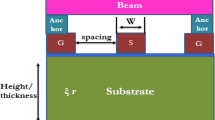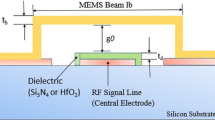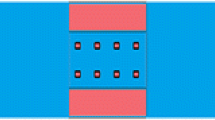Abstract
This paper presents design and simulation of uniform structured RF MEMS capacitive shunt switch using FEM tool and HFSS software. The switches with different shaped meanders and perforations which result in less spring constant, less pull-in voltage, high isolation loss, high switching speed and low insertion loss have been designed. From the simulated results it is observed that the rectangular perforations gives the better results, when compared with square and cylindrical shaped perforations. Comparative study is done for zigzag, plus and three square shaped meander along with rectangular perforations on each structure. When the gap between the dielectric and the movable beam is 0.8 µm, the up state capacitance for HfO2 is 4.06fF and for Si3N4 is 3.80fF. The downstate capacitance for HfO2, Si3N4 is 49fF, 26.9fF respectively. The capacitance ratio is 120.6. Poly-tetra-fluoro-ethylene material is given for the movable beam whose young’s modulus is 0.4 GPa and the spring constant is calculated theoretically for each structure; by using this the pull in voltage and the settling time are calculated. Step switch with three square Meander has switching time 10.25 µs, pull in voltage as 2.45 V. By using HFSS 3-D electromagnetic model we observed the return loss (S11) is less than −60 dB, the insertion loss is less than −0.07 dB in the range of 1–40 GHz frequency and switch isolation (S21) is −61 dB at 28 GHz frequency.
Similar content being viewed by others
Avoid common mistakes on your manuscript.
1 Introduction
Radio Frequency Micro Electro Mechanical Systems is an innovative and the recently emerging technology especially in the design of switching devices (Rebeiz et al. 2003). The name itself indicates that it has an interdisciplinary nature. The size of the device varies between 1 and 100 micrometres. MEMS devices combine the advantages and overcome the disadvantages of electro-mechanical switches like coaxial, waveguide switches and semiconductor switches such as PIN diodes, FETs (Molaei and Ganji 2016). As the component size is in the order of the microns, it facilitates many advantages like less consumption of power, low cost, linearity, low operating voltage, high isolation, high reliability, less insertion loss and moreover it provides an opportunity to fabricate in large arrays (He et al. 2011). As it has fabulous characteristics, it could be used in many applications like Smart Mobile device, Antennas, Space systems, Bluetooth, T/R modules, Communication. Mainly RF MEMS switches are designed for microwave applications like cell phone, short range communications like Bluetooth and WLAN, automotive industries. These devices were employed in RF, i.e., from 30 KHz to 300 GHz with different and WLAN, automotive industries. These devices were employed in RF, i.e., from 30 KHz to 300 GHz with different geometrical structures and characteristics like low insertion loss and high isolation (Angira et al. 2014).
In a short time ago many RF MEMS capacitive shunt switches have been designed and fabricated by introducing different technologies; in this paper we are presenting the design and simulations of the capacitive shunt switch which is a fixed-fixed structure in FEM Tool. In order to increase the performance of switching of the fixed-fixed structure some modifications are done to the structure; the modifications include the addition of meander, perforations to the existing structure, and also by building the step down structure to the movable beam. All the proposed structures have fixed and movable beam as parallel whereas for stepdown structure fixed beam and movable beam are separated by gap which resembles a bridge structure. Stepdown structure with 3 square meander has very low actuation voltage when compared to uniform 3 square meander structure; this is due to dielectric layer as Hfo2 is used. For uniform structures both stepdown and switch has 3 square meander, but the overall performance is better for uniform step structure with 3 square meander when compared to switch with uniform 3 square Meander. Stepdown structure with 3 square meander has very low actuation voltage up to 2.45V and high isolation upto -61dB at a frequency of 40GHz. This uniform structure with 3 square meander along with perforations has very low actuation voltage of 2.5 V, low insertion loss up to -0.07dB at a frequency of 40GHz and high isolation of -43dB at a frequency of 28GHz.
2 The structural model of MEMS shunt capacitive switch
Fixed-fixed capacitive shunt switch is the most commonly preferred switch in RF MEMS. The schematic of the proposed structure is shown in the below figure. The structure consists of a movable beam, dielectric, two fixed blocks and two anchors (Guha et al. 2016) (Figs. 1, 2).
As poly-tetra-fluoro-ethylene (PTFE) has very less weight and cost effective, it is used for movable beam, anchors, fixed blocks. Silicon nitrate (Si3N4) or hafnium oxide (HfO2) is used as dielectric (Bachman et al. 2012). Silicon dioxide that has high resistivity is used as substrate (Table 1).
2.1 Perforations
Here we observed the results by introducing the different shaped perforations in the movable beam. The perforations facilitate the switch to perform at low actuation voltages (Sharma et al. 2015). The shapes for the perforations are rectangle, square and cylindrical. Addition of these perforations decreases the mass of the beam, resulting in more deflection. Flexibility of the switch is more efficient when it is provided with rectangular-shaped perforations (Table 2).
2.2 Meander
Meander technique helps to decrease the value of pull-in voltage and increase the speed of switching of the device (Manfaineiad et al. 2013). A comparative study is done for different shaped menders with rectangular shaped perforations on each structure. The shape of meander used are plus shape, zigzag shape, three square shape (Figs. 3, 4, 5; Tables 3, 4, 5).
3 Theoretical analysis
In shunt capacitive fixed–fixed switch, RF response depends on the capacitance ratio (Shekhar et al. 2014). Up state capacitance (Con) of the switch is calculated by using the formulae
where \(C_{ON}\) is up state capacitance,\(x\) is Width of the actuation electrode, \(y\) is width of the actuation electrode, \(t_{d}\) is dielectric thickness, \({\text{g}}_{\text{o}}\) is gap between beam and dielectric, \(\varepsilon_{r}\) is relative permittivity of dielectric material, \(\varepsilon {\text{o }}\) is relative permittivity of free space. The up state capacitance varies for different materials based on their relative permittivity (Angira et al 2013). The relative permittivity of HfO2 is 14 and for Si3N4 is 7.6 (Table 6).
From the table it can be clearly observed that the capacitance value decreases as the gap between the dielectric and the movable beam increases.
Coff is the Down state capacitance and is calculated by using the formulae
where \(C_{Off}\) is down state capacitance, \(\varepsilon_{o}\) = 8.85 × 10−12 F m−1 which is called electric constant or permittivity of free space.
Down state capacitance is independent of the gap. The down state capacitance for HfO2, Si3N4 is 49fF, 26.9fF respectively.
The capacitive ratio can be calculated by ratio of up state capacitance to the downstate capacitance (Balaraman et al. 2012).
\(C_{ratio}\) is also known as figure of merit (Fedder et al. 1994), εr is relative dielectric constant. Dielectric constant for HfO2 and Si3N4 is 14 and 7.6 respectively.
4 Results and discussions
The FEM abbreviated as Finite Element Method is used to analyze the electrical and mechanical characteristics of the RF MEMS switch using electro-mechanics study in COMSOL Multi-Physics software. The electro-mechanics force is responsible for the deflections in the movable beam which enable the functioning of the switch (Ramli et al. 2012). Hence to obtain the better deflections in the switch the gap between the dielectric, movable beam is preferred as 0.8 µm and material used is HfO2 for dielectric. Figures 6 and 7 presents the basic structure of uniform switch with, without meander and the displacement is 8.27 × 10−3, 0.01 in negative direction of z-component at 2.5 V as pull in voltage respectively.
Figures 8 and 9 shows the step-down movable beam structure of uniform switch with, without meander and the displacement is 9.2 × 10−3, 7.46 × 10−7 in negative direction of z-component at 2.5 V as pull in voltage respectively.
4.1 Electro mechanical analysis
Structure of a switch is an efficient part in overall performance of the switch (Verma et al. 2013). Hence structural analysis is done by plotting the graphs for source voltage and beam deflection by varying the gap between movable beam and dielectric for switch with and without meanders and step down switch along with rectangular perforations (Figs. 10, 11, 12, 13, 14, 15, 16).
4.2 Switching analysis
RF MEMS Switch for transmit/receive switching applications parameters like low return loss and high isolation loss a very important (Lee et al. 2004). Along with these parameters switching speed is also a major factor that influence the working of switching for transmit/receive applications.
The time required for the switch to toggle from active state to inactive state and vice versa is called switching time. The switching time performance is the key parameter that to be considered for studying the switch functioning.
The switching time (ts) is calculated by using the formulae
where Vpi is the pull in voltage, Vs is source voltage, wo resonant frequency.
For the efficient performance of the switch we need the less actuation voltage and huge isolation. A low voltage MEMS switch makes it more convenient for a switch to be embedded into real applications. By using the spring constant (Kz) the pull in voltage (Vpi) can be calculated by using the below formulae
Pull-in-voltage should be as less as possible so to reduce it, the spring constant (Kz), air gap (g0) should be less. The reduction in gap may result in migration of the charges and breakdown of dielectric. The area of the switch cannot be increased as it results in increase of the size of the device. So, the probability is to lessen the value of the spring constant
The spring constant of each block is calculated by using the formulae
where Y is Young’s modulus of the material of movable beam (young’s modulus of PTFE is 0.4 GPa) W, l and t are width, length and thickness of the block. Thus the spring constant of the device mainly rely on the choice of the material used for the movable beam, dielectric and their dimensions (Verma et al. 2013).
Resonant frequency (wo) of the device explains about the physical variation of the device when it is put to stress. It is also one of the important parameter in switch performance evaluation.
where f is resonant frequency, d is density, h is beam height.
Thus the switching time for Switch without Meander is 35 µs, Switch with three square Meander is 25 µs, step switch without meander is 62 µs and step switch with three square meander is 10. 25 µs at Vs = 2 V (Figs. 17, 18).
4.3 Performance analysis
The movable beam is supplied with positive dc voltage and the dielectric acts as ground, these two conductors separated by distance acts as a capacitor and capacitance is developed between them. The switch can be demonstrated as a capacitor between the movable beam and the dielectric. Proposed microwave characteristics are considered using HFSS software.
Return loss S11 is defined as the measure of efficient impedance matching of the devices. It is usually represented as negative number. It is measured in dB.
Insertion loss and isolation are represented by S21 parameter.
When the switch is in OFF and ON state respectively (Patil et al. 2013).
High isolation loss in the on state of the switch and the less insertion loss in the off state of the switch are obtained when the down state capacitance is high and the up state capacitance is low (Molaei and Ganji 2016) (Figs. 19, 20, 21; Table 7).
5 Conclusion
In this paper, Comparative analysis for Fixed–Fixed RF MEMS Capacitive Shunt switch with, without meanders and also step down structure of the movable beam is done to obtain less pull in voltage, low insertion, return losses and high isolation and is investigated under 1–40 GHz for k-band applications at different applied voltages. From the simulated results it is observed that the rectangular perforations gives the better results, when compared with square and cylindrical shaped perforations. So the structures with zigzag, plus and three square shaped meander are provided with rectangular perforations on the movable beam of each structure. Step switch with three square Meander has switching time 10.25 µs, pull in voltage as 2.45 V. The material dependency is a major contribution for switching time and Structural Analysis of Shunt Capacitive switch. The Dielectric material is used as Si3N4 and HfO2, HfO2 obtained better results, as its dielectric constant is high. Further the Performance analysis depends on S-parameters and the observed results are the return loss (S11) is less than −60 dB, the insertion loss is less than −0.07 dB in the range of 1–40 GHz frequency and switch isolation (S21) is −61 dB at 28 GHz frequency.
References
Angira M, Rangra K (2014) Design and investigation of a low insertion loss, broadband, enhanced self and hold down Power RF-MEMS switch. Microsyst Technol 21(6):1173–1178. doi:10.1007/s00542-014-2188-6
Angira M, Sundaram GM, Rangra K, Bansal D, Kaur M (2013), On the investigation of an interdigitated, high capacitance Ratio shunt RF-MEMS switch for X-band applications. In: Proceedings of NSTI nanotechnology, Washington 2, pp 189–192
Bachman M, Yang Z, Minfeng W, Li G (2012) High-power magnetically actuated microswitches fabricated in laminates. IEEE Electron Device Lett 33(9):1309–1311. doi:10.1109/LED.2012.2206553
Balaraman D, Bhattacharya SK, Ayazi F, Papapolymerou J (2012) Low-cost low actuation voltage copper RF MEMS switches. IEEE Microw Theory Tech Symp 2:1225–1228
Fedder GK (1994) Simulation of micro-electro-mechanical systems. Ph.D. dissertation, Electrical Engineering and Computer Science, University of California at Berkeley, USA
Guha K, Kumar M, Parmar A, Baishya S (2016) Performance analysis of RF MEMS capacitive switch with non-uniform meandering technique. Microsystem Technologies, vol 22. Springer Berlin Heidelberg, pp 2633–2640
He X, Lv Z, Liu B, Li Z (2011) Electro thermally actuated RF MEMS capacitive switch with automatic layer deposited (ALD) dielectrics. (Solid-state Sensors, Actuator sand Microsystems Conference, (TRANSDUCERS)
Lee J, Yang WS, Kang S, Choi CA (2004) Design and parameter-extraction based small-signal modelling of a novel center-anchor MEMS series switch. In: Proceedings of the 34th European microwave conference, Amsterdam, The Netherlands, pp 1433–1436
Manfaineiad Y, Zarghami M, Kouzani AZ (2013) Design and simulation of high isolation RF MEMS shunt Capacitor switch for C-K band. Electrical Engineering (ICEE), 21st Iranian conference, Mashhad, pp 1–5
Molaei S, Ganji BA (2016) Design and simulation of a novel RF MEMS shunt capacitive switch with low actuation voltage and high isolation. Springer-Verlag, Berlin Heidelberg
Patil GD, Kolhare NR (2013) A review paper on RF MEMS switch for wireless communication. Int J Eng Trends Technol 4(2):195–198
Ramli N, Sidek O (2012) Reducing an actuation voltage of RF MEMS capacitive switch through three electrodes topology using architect coventorware. J Eng Technol 2(2):46–51. ISSN 2231-8798
Rebeiz GM (2003) RF MEMS: theory, design and technology, 3rd edn. Wiley, New Jersey
Sharma A, Shah A, Bharti R (2015) Design and simulation of low actuation voltage perforated shunt RF MEMS switch. Int J Eng Tech Res 3(6). ISSN 2321-0869
Shekhar S, Vinoy KJ, Ananthasuresh GK (2014) Design and characterization of capacitive RF MEMS switches with low pull-in voltage. Microwave and RF conference (IMaRC), IEEE International, pp 182–185
Verma P, Singh S (2013) Design and simulation of RF MEMS capacitive type shunt switch & its major applications. IOSR J Electron Commun Eng (IOSR-JECE) 4(5):60–68. e-ISSN 2278-2834, p-ISSN 2278-8735
Acknowledgements
Dr.K.Srinivasa Rao would like to thank SERB (Science Engineering Research Board), Govt. of India, New Delhi, for providing partial financial support to carry out this research work under ECRA Scheme (File No: SERB/ECR/2016/000757). The authors would like to thank NMDC, supported by Govt. of India, for providing necessary design facilities through NPMASS.
Author information
Authors and Affiliations
Corresponding author
Ethics declarations
Conflict of interest
The authors declare that they have no competing interests.
Rights and permissions
About this article
Cite this article
Ravirala, A.K., Bethapudi, L.K., Kommareddy, J. et al. Design and performance analysis of uniform meander structured RF MEMS capacitive shunt switch along with perforations. Microsyst Technol 24, 901–908 (2018). https://doi.org/10.1007/s00542-017-3403-z
Received:
Accepted:
Published:
Issue Date:
DOI: https://doi.org/10.1007/s00542-017-3403-z

























